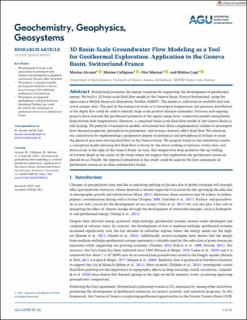3D Basin-Scale Groundwater Flow Modeling as a Tool for Geothermal Exploration: Application to the Geneva Basin, Switzerland-France
Peer reviewed, Journal article
Published version

Åpne
Permanent lenke
https://hdl.handle.net/11250/2995286Utgivelsesdato
2021Metadata
Vis full innførselSamlinger
- Publikasjoner fra CRIStin - SINTEF AS [5801]
- SINTEF Digital [2501]
Originalversjon
Geochemistry Geophysics Geosystems. 2021, 22, (5), e2020GC009505. 10.1029/2020GC009505Sammendrag
Switzerland promotes the energy transition by supporting the development of geothermal energy. We built a 3D basin-scale fluid flow model of the Geneva Basin, France-Switzerland, using the open-source Matlab Reservoir Simulation Toolbox (MRST). The model is calibrated on available well and active seismic data. The goal of the numerical study is to investigate temperature and pressure distribution at the depth that could be used to identify large-scale positive thermal anomalies. Previous and ongoing projects have assessed the geothermal potential of the region using static conductive models interpolated from bottom hole temperatures. However, a consistent basin-scale fluid flow model of the Geneva Basin is still lacking. We perform 14 numerical models, articulated into three complementary studies to investigate how thermal properties, petrophysical parameters, and tectonic features affect fluid flow. We constrain our simulations by implementing a progressive degree of geological and petrophysical realism to study the physical processes driving fluid flow in the Geneva basin. We propose based on the simulation results a conceptual model showing that fluid flow is driven by the down-welling of meteoric waters that cool down rocks at the edge of the Geneva Basin. In turn, this temperature drop promotes the up-welling of warmer fluids in the center of the basin where we suggest that exploration for geothermal resources should focus. Finally, the approach presented in this study could be used for the first assessment of geothermal resources in other sedimentary basins.